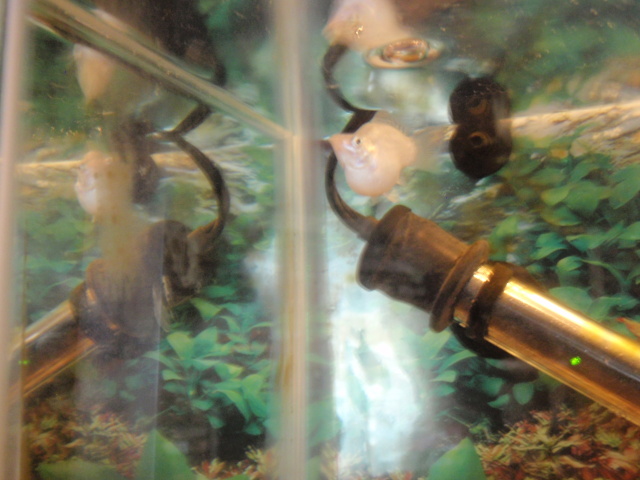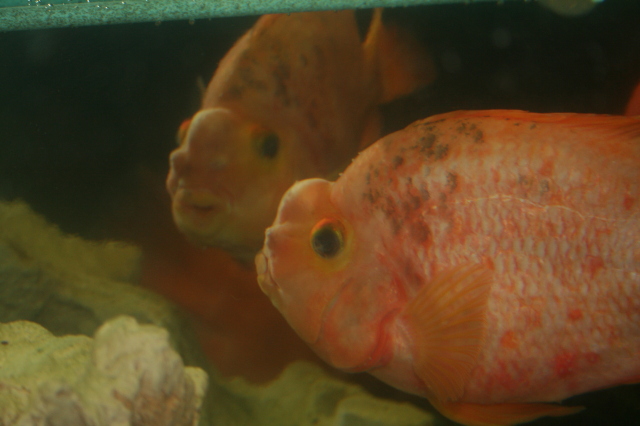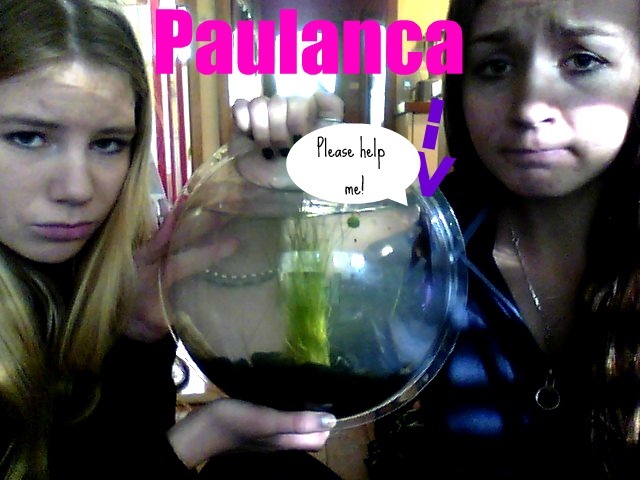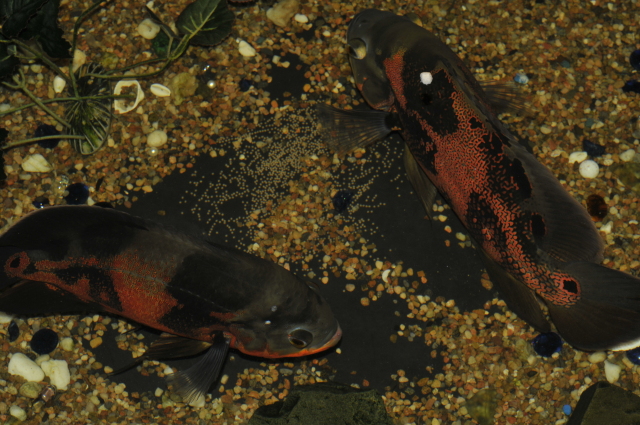QuestionMy parents recently bought a 75 gallon aquarium (together with a filter and an oxygen tank--is that right?) as a present to the younger ones. We've had the aquarium for about three weeks now. Before that, we had a 5 gallon aquarium containing 2 golden sharks and 2 janitor fish that we had been maintaining for about 5 months. Other than that, we have no experience in aquarium or fish care whatsoever. The golden sharks and janitor fish are now in the bigger aquarium, together with 24 other small-sized fish my parents bought on a whim. The 24 include 10 molly, 4 sharks, 4 angelfish, 2 goldfish, 2 nightfish and 2 albino janitor fish. I am very aware that this is not an acceptable combination, but the people at the petshop where my parents got the fish told them that it is ok. So far, 3 of the molly have already died (they are the smallest among the lot). The other fish seem to be getting along fine, they have their own "territories" on the aquarium floor, which, save for the sand and three big rocks, is bare. What do you think should we do with the fish? Is it really bad to mix very active fish with "peaceful" fish? I already told my parents to give away the other fish, as they would eventually die anyway, given the situation. Am I right? Among all the fish, my parents like the angelfish and nightfish the best, so I am sure that if they do give away some of the fish, those ones are going to stay. The nightfish, by the way, never seem to eat. They don't seem to like the sinking pellets we feed them. Why do you think is this so? All the others have no problem with feeding, they are in fact, getting obviously bigger and fatter. I have no idea what to do with the fish anymore, I need all the professional help I can get. Help!
AnswerHi Sandi;
Hopefully they won't buy any more fish for at least another month. The tank is still in the break-in period and there are often losses when too many fish are added to start out the tank. The break-in or cycling period takes a total of 6 to 8 weeks after the first fish is added.
The combination of fish doesn't sound too bad really. The only ones I would get out of there are the goldfish. they are cold water fish and will not do well long term in a tropical tank. They will grow to eat most of the other fish anyway.
Here is my article on new tanks to help all of you know how to handle it;
**********
New Tank Syndrome or Break-in Period
So you have a new tank and you filled it up, put the filter together, mounted the heater into place and turned on the lights. You have all the plants and decorations where you want them....
You are ready for fish.
But, your filter is not ready for a full tank of fish yet.
The filter is running and moving the water and cleaning out crud, right? Of course!
But a very important part of your filter is the part you can't see. An aquarium filter removes the larger visible stuff, but it also must remove the dissolved fish waste that turns into ammonia in the water. To do this, special bacteria must grow in the filter system and on the particles of gravel in the bottom of your tank. This process occurs even on a limited scale in little fish bowls that have no filter in them.
This is "New-Tank Syndrome" or the "Break-in Period". The entire process takes 6 to 8 weeks to complete because these "nitrifying" bacteria grow quite slowly.
Start off with only two hardy fish for every ten gallons of water and don't add more until the 6 to 8 weeks has gone by. Hard to be patient, but it is worth it to keep your fish alive and healthy. As a matter of fact, the bacteria cannot develop without fish in the tank. You can let that tank sit forever without fish in it, but as soon as the first fish goes in the process begins. Avoid changing the filter pads during break-in. This removes the bacterial colonies that are essential to a balanced aquarium. You can rinse the filter pad out in a container of aquarium water. This will preserve most of the bacteria colonies while still allowing your filter to flow freely. Even using bacteria additives and water conditioners when you first set up the tank will not make a tank cycle by itself. If there are no fish to provide food (fish waste) for the bacteria, the beneficial bacteria cultures will die and you will have to start the colonies all over again once fish are added to the tank.
Feed your new fish VERY lightly. Any excess food will cause additional waste your system cannot afford to have right now. If you see food floating around or lying on the plants and gravel after five minutes, too much food is going into the tank. Cut back a little each time you feed until it is ALL gone 5 minutes after you feed them.
During this "break-in period" your tank will become cloudy and milky looking. You may have to tolerate this for the entire break-in period but it is only temporary. Changing 25% of the water three times a week until the break-in period is over helps a great deal. Changing water reduces the ammonia and nitrites that rise while the bacteria continues to multiply. If ammonia and/or nitrites become too high, your fish will become stressed and possibly die. Use a good water conditioner when you replace the water and make sure it is the right temperature to avoid shocking your fish.
When the break-in is over after 6 to 8 weeks and there are no nitrites or ammonia present in the water you can slowly add more fish. Add one or two every week until you reach the desired population. This allows the bacteria to adjust to the new population every time before adding more. Monitor the nitrites and ammonia to be sure they don't come up. If they do, make a 25% water change and check them again. Don't add the next fish until the levels are down again.
The safe maximum population for any size tank is one inch of adult fish for every gallon of water in the tank. Do some research to be sure of the fish you are interested in. Even though they are small when you buy them, you have to base your population calculations on full-sized adult fish. Many hobbyists have up to two inches per gallon but this can be risky. If a water quality issue arises or a disease occurs it will spread fast and furious in an over-populated tank. In any case, 25% water changes every week to two weeks are absolutely essential for the health of your fish.
Following these guidelines will help you get your new tank on the right track.
**********
Come on over and join us on the freshwater fish forum at About.com to get even more information too;
http://forums.about.com/ab-freshaquaria/start
My member name is ChrisR62. See You There!
Followups welcome
At Your Service;
Chris Robbins

 Pregnant Balloon Molly
Question
Pregnant Balloon Molly
This balloon molly has
Pregnant Balloon Molly
Question
Pregnant Balloon Molly
This balloon molly has
 Please Help!!!!
Question
Gracie
I woke up this morning only to f
Please Help!!!!
Question
Gracie
I woke up this morning only to f
 I Think I made my Flowerhorn Really Sick
Question
sick flowerhorn
Hia Ron,
Ok let me just
I Think I made my Flowerhorn Really Sick
Question
sick flowerhorn
Hia Ron,
Ok let me just
 My Betta Fish; Sir Paulanca the 2nd.
Question
Sir Paulanca the 2nd
Ive had Paulanca for a bi
My Betta Fish; Sir Paulanca the 2nd.
Question
Sir Paulanca the 2nd
Ive had Paulanca for a bi
 oscars breeding and egg laying
Question
Oz & Hobbs +
i have two african cichlids,
oscars breeding and egg laying
Question
Oz & Hobbs +
i have two african cichlids,